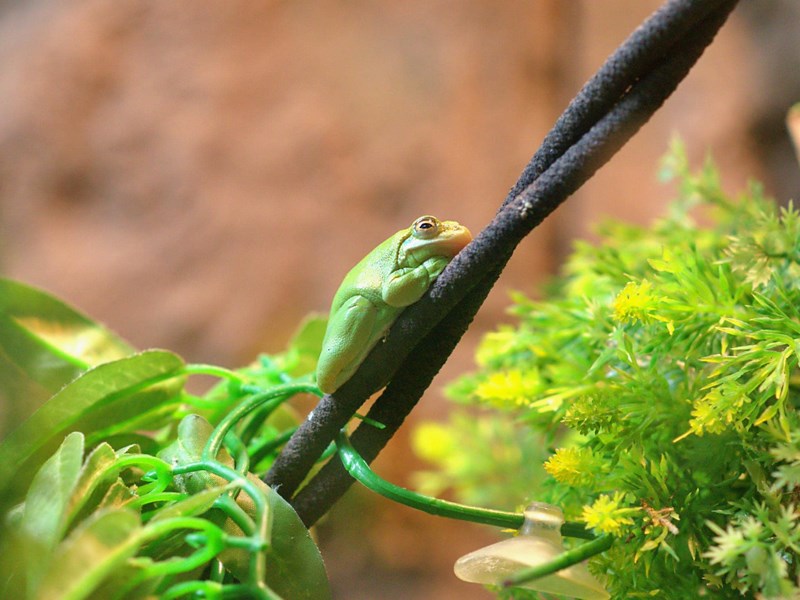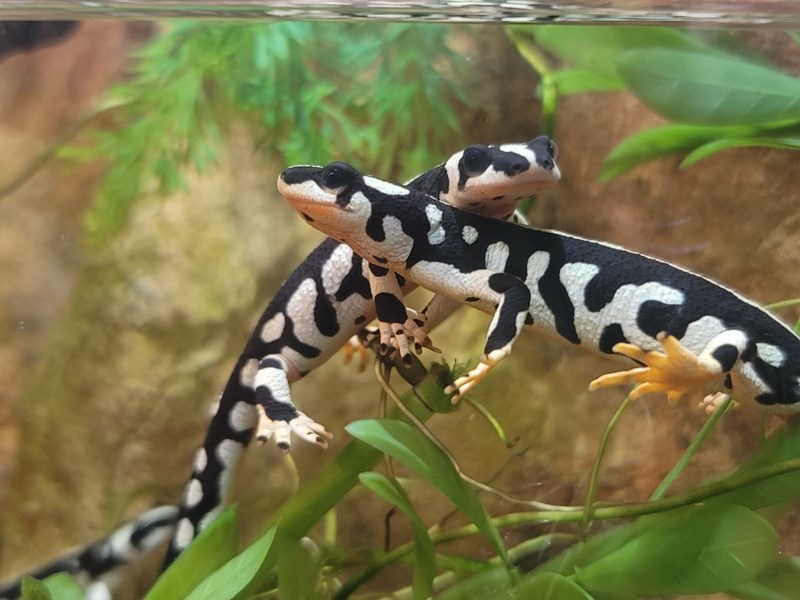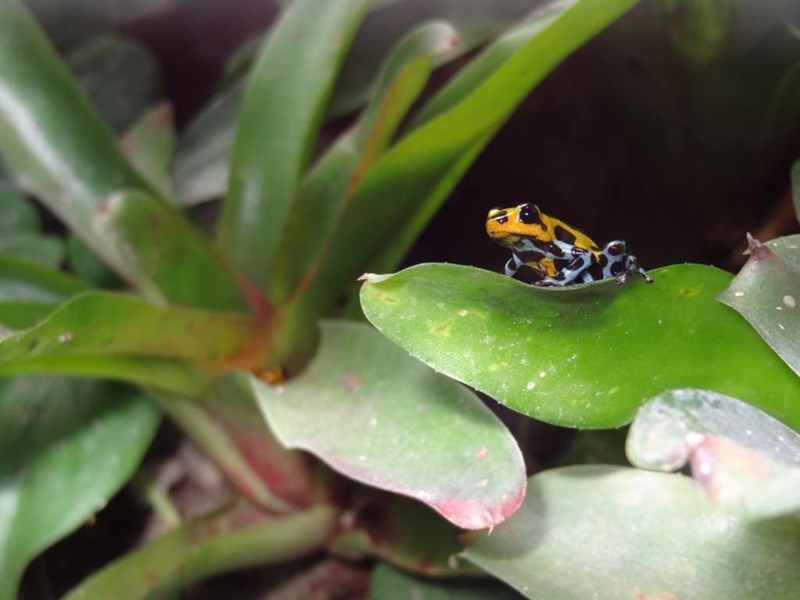Amphibians
Amphibians, such as frogs, toads, salamanders, and newts, are a diverse group of animals characterized by their ability to live both in water and on land. These fascinating creatures play crucial roles in ecosystems around the world. As indicators of environmental health, amphibians are sensitive to changes in their habitats, making them important bioindicators for monitoring ecosystem health. Additionally, they serve as both predators and prey, helping to control insect populations and contributing to the overall balance of food webs. Furthermore, many amphibians possess unique adaptations and behaviors that contribute to scientific research and medical advancements. By educating visitors about the importance of amphibians, the Little Rock Zoo aims to foster appreciation for these remarkable animals and promote conservation efforts to ensure their survival in the wild. Learn more about the resident amphibians you can see in the Reptile House at the Little Rock Zoo.




Anthony’s Poison Arrow Frog
Anthony’s Poison Arrow Frog (Epipedobates anthonyi), also known as Anthony’s Dart Frog, is a small and colorful amphibian native to the humid tropical rainforests of Ecuador and Peru. These frogs are renowned for their striking appearance, with vibrant colors ranging from red to orange and sometimes even yellow, adorned with dark stripes or spots. Despite their small size, usually growing to about 2 centimeters in length, they are a standout species in the amphibian world.
The bright coloration of Anthony’s Poison Arrow Frog serves as a warning to predators about their toxicity. In the wild, these frogs produce a potent toxin through their skin, derived from their diet of ants and other small invertebrates.
Habitat/Range:
Primarily terrestrial, but requiring habitat near streams for breeding, the Anthony’s Poison Dart Frog usually lives in primary (undisturbed natural) and secondary (deforested) tropical rainforests and grasslands on slopes of the Andes Mountains.
Size:
0.75 to 0.8 inches (2.0 to 2.2 centimeters)
- The most remarkable feature of the Anthony’s Poison Dart Frog is that its bones are green.
- Their toxin is now being produced synthetically in pharmaceutical laboratories, where it is being evaluated as a non-addictive substitute for morphine.
- In the wild, these frogs produce a potent toxin through their skin, derived from their diet of ants and other small invertebrates. Interestingly, in captivity, where their diet is different, these frogs lose their toxicity, making them safe to handle under controlled conditions.
- Males guard and keep eggs moist, then move the hatched tadpoles to a pool or stream so they can continue to develop.
The Anthony’s Poison Dart Frog is known in only seven small locations in Ecuador. Populations are limited and numbers are declining in the northern portion of its range, where some distinct population segments have even disappeared. The reason may be due to its limited estimated range of less than 1,900 square miles (5,000 square kilometers).
Kaiser Newt
Kaiser Newts, also known as Luristan Newts, are native to the Zagros Mountains of Iran. These striking amphibians are known for their vibrant colors, with bright orange or red dorsal markings contrasted against a black or dark blue body. Kaiser Newts are semi-aquatic, spending their time both in water and on land. They inhabit mountain streams and pools in their natural habitat and are known for their playful and inquisitive nature. Kaiser Newts are carnivorous, feeding on a diet of small invertebrates and aquatic insects.
Habitat/Range:
This newt is found in only four streams within a 6.2 square mile (10 square kilometer) area in the southern Zagros Mountains in the Luristan Province of Iran.
Size:
Adults grow to a length of approximately 4 inches making them the smallest species of this genus.
- Kaiser mountain newts get their common name from the small area where they are found in Iran.
- During the hot dry summer, water may not be available so this newt may estivate by going underground where it is cooler and possibly more humid. Estivation is similar to hibernation.
- Their bright coloration serves as a warning to predators not to eat it.
Kaiser mountain newts are critically endangered due to pet trade exploitation, small native range, loss of habitat, damming of their streams, and severe drought. They are classified under Appendix 1 of CITES. They are also protected by the Iranian government. There are captive breeding programs in Iran, Europe, and the United States.
Oriental Fire-Bellied Toad
Oriental Fire-Bellied Toads, are charming amphibians native to Asia, particularly found in China, Korea, and Russia. Known for their vibrant green and black back coloration, complemented by bright orange or red bellies adorned with dark markings, these toads are a sight to behold. Their striking appearance serves as a warning to potential predators of their toxic skin secretions, which contain chemicals that can cause irritation. Oriental Fire-Bellied Toads inhabit a variety of wetland habitats, including ponds, marshes, and slow-moving streams, where they feed on insects, small invertebrates, and occasionally small fish. They are famous for their acrobatic behaviors, often seen climbing vegetation and swimming with agility.
Range/Habitat:
Oriental fire-bellied toads can be found in northeast China, Korea, Thailand, southern Japan and southeast Russia. They can live in a variety of habitats including forests, river valleys, swampy bushlands, and open meadows. They will live in near a body of water.
Size:
Length: 1.4-3.2in.
- When threatened, these toads will flip onto their backs and arch their backs. This shows off their brilliantly colored belly, warning predators that they are poisonous to eat. This posture is known as unkenreflex.
- In cases of extreme danger, oriental fire-bellied toads can excrete so much poison that their entire body becomes covered in a soapy foam.
- These toads are actually frogs.
IUCN lists as a species of least concern. It is listed on the Red Data Book of Khabarovskii Region, Russia, which is like their endangered species list. They are threatened by habitat loss, and are collected in Russia for sale to China to be used in medicine. This species is popular in the pet-trade.
Poison Dart Frogs
(Dyeing, Green and Black, Yellow-Headed)
Poison dart frogs, scientifically known as Dendrobatids, are a family of small, brightly colored frogs native to Central and South America. Renowned for their dazzling hues and fascinating behaviors, these frogs are a highlight of tropical rainforests. Despite their size, ranging from less than an inch to a few inches in length, poison dart frogs possess potent skin toxins, derived from the insects they consume in the wild. This toxicity serves as a defense mechanism against predators, and in some indigenous cultures, the toxins are used to create poison-tipped darts for hunting, hence their common name. Poison dart frogs exhibit complex social behaviors, including elaborate courtship displays and parental care, where males and females work together to raise their offspring. At the Little Rock Zoo, visitors can marvel at the vibrant colors and learn about the ecological importance of these enchanting amphibians, as well as the conservation efforts aimed at preserving their habitats in the wild.
Range/Habitat:
This family of frogs range from Nicaragua to Brazil with the majority living in northwestern South America. They inhabit, moist, tropical rainforest.
- The name dart-poison frog is derived from a practice of the Native People of the Ember Choco in Colombia, in which they rub their blowgun darts onto the backs of golden poison frogs to load the darts with poison.
- The skin of poison frogs contains a potent toxin derived from the insects they consume in the wild. This alkaloid-based toxin acts as a defense mechanism against predators, capable of causing paralysis or even death. However, poison dart frogs kept in captivity typically do not possess the same level of toxicity as their wild counterparts, as their diet differs from that of their natural habitat.
These species are listed by IUCN as anywhere from least concern to endangered. Many species are threatened by habitat destruction and disease. Bd chytrid fungus threatens numerous amphibian species by hardening the keratin in their skin and making them unable to breathe. This fungus has spread to many countries throughout the world and threatening many species with extinction.
White’s Tree Frog
The White’s Tree Frog, is a charming amphibian native to Australia, Indonesia, and Papua New Guinea. Known for its endearing appearance and gentle disposition, this species is a popular choice among frog enthusiasts and pet owners alike. With its distinctive lime-green coloration and creamy white underside, the White’s Tree Frog is easily recognizable. It spends much of its time perched on branches or hiding among foliage, earning it the nickname “dumpy tree frog” due to its plump appearance. Despite its arboreal lifestyle, this species is an adept swimmer and can often be found near bodies of water in its natural habitat.
Habitat/Range:
This tree frog is found in Australia and southern New Guinea. They like moist forest habitats but have adapted so that they can live in drier conditions as well.
Size:
length: 3-4.5in.
- The female can deposit her eggs with such vigor that they can land half a meter away.
- They can control how much water evaporation occurs through their skin and in this way they can regulate their temperature.
- They have vomerine teeth (roof of their mouth) which aid in digestion by holding the prey in place as they swallow it whole.
- The have horizontal pupils unlike most other tree frogs.
Least Concern. These frogs are common in their natural range. However, the chytrid fungus, habitat loss, pollution, and the pet trade are harming natural populations.
Amazon Milk Frog
The Amazon Milk Frog (Trachycephalus resinifictrix) is a striking amphibian native to the tropical rainforests of the Amazon Basin in South America. Known for their distinctive coloration, these frogs feature a creamy white or light gray body with bold black or dark brown markings. This coloration helps them blend into the bark and branches of trees, providing excellent camouflage.
Amazon Milk Frogs are arboreal, meaning they spend most of their lives in trees. They inhabit the upper canopy, where the humidity is high, and they can easily find food and mates. These frogs get their name from the milky secretion they produce when threatened, which helps deter predators.
Habitat/Range:
Amazon milk frogs (Trachycephalus resinifictrix) are found in the tropical rainforests of South America. Populations are widespread in Guyana, Colombia, Brazil, Ecuador and Peru.
Size:
They range from 2.5-4 inches in length with females being larger than males.
- These amphibians received the name “milk frog” from the sticky white substance they secrete through their skin when threatened. This substance is poisonous to potential predators.
- Milk frogs are arboreal, and spend their lives in trees and other plants. Milk frogs have special toe-pads on their feet to help them climb plants. They can hold up to 14 times the animal’s body weight!
The IUCN (International Union for the Conservation of Nature) lists these frogs as a species of Least Concern due to their extensive range and currently stable population.
Chuxiong Firebellied Newt
The Chuxiong Firebellied Newt (Cynops cyanurus) is a captivating amphibian native to the subtropical regions of China, specifically in Yunnan Province. These newts are named for their striking coloration: a dark, almost black back and a vibrant, fiery red or orange belly. This bold coloration serves as a warning to potential predators about the toxic substances the newt can secrete when threatened.
Habitat/Range:
The Chuxiong Firebellied Newt (Cynops cyanurus) are found in Guizhou and Yunnan in southwestern China
Size:
Cynops cyanurus is a relatively small salamander, with male total length reaching up to 80 mm, and females measuring up to 100 mm.
- The Chuxiong Fire Bellied Newt is known for its striking coloration, with a dark, almost black back and a vibrant red or orange belly that serves as a warning to predators about its toxic secretions
- The bright belly coloration is not just for show. It indicates the presence of toxic substances that the newt can secrete when threatened, deterring potential predators
- The presence of Chuxiong Fire Bellied Newts in an ecosystem is a good indicator of environmental health, as they are sensitive to pollution and habitat destruction
The IUCN (International Union for the Conservation of Nature) lists these salamanders as a species of Least Concern due to their currently stable population.
Lemur Tree Frog
The Lemur Tree Frog (Hylomantis lemur) is a fascinating amphibian known for its vibrant coloration and unique behavior. Native to the tropical rainforests of Central and South America, particularly in countries like Costa Rica and Panama, this species thrives in the lush, humid environments of these regions.
Habitat/Range:
The Lemur Tree Frog (Hylomantis lemur) in tropical rainforests of Central and South America. hese frogs are arboreal, meaning they spend most of their lives in trees, and are excellent climbers with specialized toe pads that help them navigate their vertical world.
Size:
Female leaf frogs are typically larger than males, ranging from 4-5 centimeters long while males are 3-4 centimeters long.
- Characterized by its bright green body and distinctive black markings, the Lemur Tree Frog is aptly named for its lemur-like, wide-eyed appearance. Its coloration provides effective camouflage among the leaves and branches of its arboreal habitat.
- During the breeding season, the female Lemur Tree Frog lays eggs on the underside of leaves, which then hatch into tadpoles that develop in small pools of water. This reproductive strategy helps protect the eggs from potential predators on the forest floor.
- Interestingly, they can change their color based on whether they are active or resting — at night when they are active, they turn brown to camouflage themselves from predators.
The lemur leaf frog (Hylomantis lemur) is critically endangered and its population has declined by more than 80% in the last 10 years. The IUCN classifies the species as critically endangered due to threats from habitat loss, the fungal disease chytridiomycosis, climate change, and the pet trade.
Solomon Island Leaf Frog
The Solomon Island Leaf Frog (Ceratobatrachus guentheri), also known as Gunther’s Triangle Frog, is an intriguing species native to the Solomon Islands. This unique frog is known for its remarkable leaf-like appearance, which provides excellent camouflage against the forest floor and helps it evade predators.
Habitat/Range:
Solomon Island Leaf Frogs are found on the Solomon Islands and Papua New Guinea, Bougainville, and Buka Islands. They are terrestrial and can be found in the damp, leaf-littered environments of their tropical rainforest habitat.
Size:
Average size is 3 to 4 inches (7.6 to 10 cm) long for females. Males are slightly smaller.
- This unique frog is known for its remarkable leaf-like appearance, which provides excellent camouflage against the forest floor and helps it evade predators.
- Unlike many other frog species that lay their eggs in water, these frogs lay their eggs on land. The eggs undergo direct development, meaning they hatch into miniature versions of the adults, bypassing the tadpole stage entirely. This adaptation is particularly beneficial in their terrestrial environment.
The The IUCN (International Union for the Conservation of Nature) lists these salamanders as a species of Least Concern due to their currently stable population.
Gray Tree Frog
The Gray Tree Frog (Hyla versicolor) is a remarkable amphibian native to North America, commonly found in forests, swamps, and gardens across the eastern United States and southeastern Canada.
Habitat/Range:
The gray tree frog’s range covers much of the eastern United States, from northern Florida to central Texas and north to parts of southeastern Canada. It is a largely arboreal species that occupies a variety of wooded habitats and is frequently found in forests, swamps, on agricultural lands and in backyards.
Size:
Adult male gray tree frogs are around 1.25-2 inches (32-52 millimeters) in length. Females are typically slightly larger than males, ranging from 1.5-2.25 inches (38-60 millimeters) in length.
- Known for their exceptional camouflage abilities, Gray Tree Frogs can change their skin color from gray to green to blend seamlessly with their surroundings, providing them excellent protection against predators.
- During hibernation, 80 percent of their body freezes and the eye becomes opaque as breathing and heartbeat are temporarily suspended.
The IUCN (International Union for the Conservation of Nature) lists these salamanders as a species of Least Concern due to their currently stable population.
Green Tree Frog
The Green Tree Frog (Hyla cinerea) is a small, vibrant amphibian commonly found in the southeastern United States. Recognized by its bright green color and distinctive white or yellow stripe running along its sides, this frog is a favorite among both wildlife enthusiasts and casual observers.
Habitat/Range:
The green tree frog’s range covers much of the central and south eastern United States. It is a largely arboreal species that occupies a variety of wooded habitats and is frequently found in forests, swamps, on agricultural lands and in backyards.
Size:
They grow to only about 6.5 cm (2.5 in) in length.
- The green tree frog, the Louisiana State Amphibian, can change from grey when it is cold to bright green when it warms up.
- This frog produces several calls including territorial, alarm, encounter and courtship calls. It is often called “rain frog” because it produces a quacking noise when it rains.
The IUCN (International Union for the Conservation of Nature) lists these salamanders as a species of Least Concern due to their currently stable population.
Fowler’s Toad
The Fowler’s Toad (Anaxyrus fowleri) is a small, robust amphibian native to the eastern United States. Characterized by its gray or brown skin covered with dark blotches and warty texture, this toad is a common sight in a variety of habitats, from woodlands and fields to suburban gardens and parklands.
Habitat/Range:
This species occurs throughout most of the temperate eastern United States and parts of southeastern Canada. Fowler’s Toads are adaptable and can thrive in both dry and moist environments, often found near bodies of water such as ponds, streams, and marshes during the breeding season.
Size:
Fowler’s toads are a small toad species with adults ranging in size from 2 to 3.5 inches in length (5 to 9.5 centimeters).
- As with other toads, Fowler’s toads have skin secretions that are toxic or distasteful to many predators.
- Female Fowler’s toads lay eggs in strings with clutches of up to 20,000 eggs.
TThe IUCN (International Union for the Conservation of Nature) lists these salamanders as a species of Least Concern due to their currently stable population.
Southern Leopard Frog
The Southern Leopard Frog (Lithobates sphenocephalus) is a common and charismatic amphibian native to the southeastern United States. Southern Leopard Frogs are highly adaptable and can thrive in a variety of wetland habitats.
Habitat/Range:
Shallow freshwater areas are preferred habitat for the southern leopard frog, but they may be seen some distance from water if there is enough vegetation and moisture to provide protection. Southern leopard frogs are also able to live in brackish marshes along the coast. Southern leopard frogs range throughout the eastern United States, from New Jersey east as far as Nebraska and Oklahoma and south into the eastern third of Texas.
Size:
The southern leopard frog grows to a length of 2 to 3.5 inches (about 5 to 9 cm).
- They are primarily nocturnal and are most active during the warmer months. These frogs feed on a diet of insects, spiders, and other small invertebrates, playing a crucial role in maintaining the balance of their ecosystems.
- Southern leopard frogs are commonly hunted by humans for food and for use in the bait trade.
- Southern leopard frog eggs can hatch earlier than normal if predators are nearby.
The IUCN (International Union for the Conservation of Nature) lists these salamanders as a species of Least Concern due to their currently stable population.



